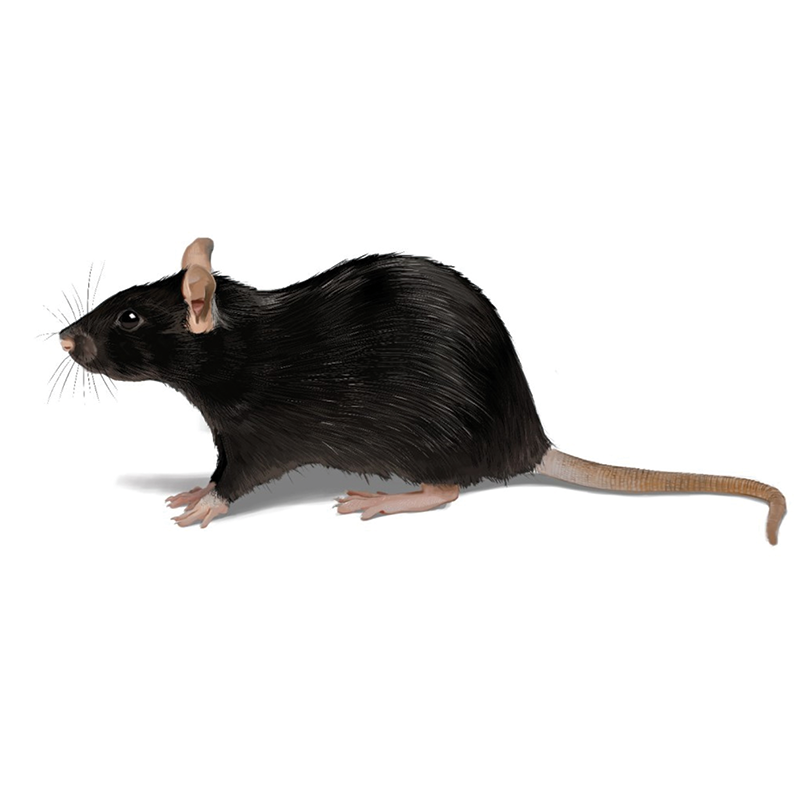
Rattus rattus
Color: Black
Shape: Long
Size: 16 inches total (6-8 inch body plus 6-8 inch tail)
Originating in Southeast Asia, roof rats get their name from their love of climbing and living in high buildings. Ranging 6-8 inches in length, not including their tails, roof rats are colorblind and have very poor vision. They do, however, have extremely strong senses of hearing, smell, touch, and taste.
What Do Roof Rats Do?
Smaller and with longer tails than Norway rats, roof rats are well adapted for climbing vines, wires, ropes, and narrow ledges. Skittish, smooth-furred, and not well adapted to cooler temperatures, roof rats are often mistaken for house mice.
Though they may be cute, these critters can cause major damage by chewing on housing materials and eating stored foods. In late fall, roof rats seek out warm nesting sites like the upper levels of your home or garage. Becoming sexually mature in a matter of months, roof rats typically have 5-8 babies per litter and 4-6 litters per year. Though they will eat meat and grain, roof rats love to feed on fresh fruit, plant materials, nuts, seeds, vegetables, tree bark, and bird feed.
How to Prevent a Roof Rat Infestation
To prevent rats from entering your home, seal up any holes or cracks larger than a quarter.
To make an ideal home, roof rats need food, water, and a cozy nesting site, so clean out wood piles, rake up fallen vegetation and fruit, and do not leave pet food or water outside, especially overnight. Keep garbage cans tightly secured, store bulk food in sealed plastic containers, and check for sources of standing water, since roof rats need an ounce of water a day. Since roof rats may enter your home through ill-fitting doors, windows, screens and air vents, seal any openings with caulk, wood, and mesh, and secure floor drains and sewer pipes with tight-fitting grates.
Signs of a Roof Rat Infestation
Look for signs of hollowed-out fruits, capsule-shaped droppings about ¼ to ½ an inch in length, gnaw marks on your home or trees, grease and urine stains, live or dead rats, or rodent odors. Check insulation for nesting sites, inspect exposed wiring for gnaw marks, and listen for the sounds of rats running or digging inside walls, attics, garages, or chimneys. These tenacious creatures can chew through wood, plastic, aluminum siding, sheetrock, and even soft metals.
How to Repel Roof Rats
Before the weather gets too cold, seal your home by covering any holes larger than ¼ inch with steel mesh or cement, and seal up and repair air vents.
Remove sources of standing water, no matter how small, including plant saucers, water fountains, birdbaths, and leaky faucets.
Getting Rid of Roof Rats
Once you find their preferred routes, place bait and live traps along these highly traveled pathways. Bait your traps with peanut butter or cat food and place the trap in a shoebox with a small hole cut in the side.
Are Roof Rats Nocturnal?
Roof rats are most active between dawn and dusk, which is most likely when they will be heard if you have an infestation. Capable of squeezing into spaces smaller than ½ an inch, these nocturnal critters love to nest in trees, attics, roof lines, and ceilings, as they prefer living more than 4 feet off the ground, where they build leafy nests for their young.
Are Roof Rats Dangerous?
Notoriously hard to eradicate, roof rats secured their place in history by spreading the bubonic plague that decimated Europe in the Middle Ages.
To this day they pose some threats to humans. Besides being carriers of ectoparasites, these cute little destroyers also love chewing on wires in your home or car and will gnaw on nearly anything to keep their incisors from overgrowing. They can cause structural damage by undermining the foundations of buildings, roads, and walkways, and have been known to chew through plastic and lead pipes, doorframes, upholstery, and electrical wires.
If you suspect a roof rat problem, contact Rochester Pest Pro for a quote.
